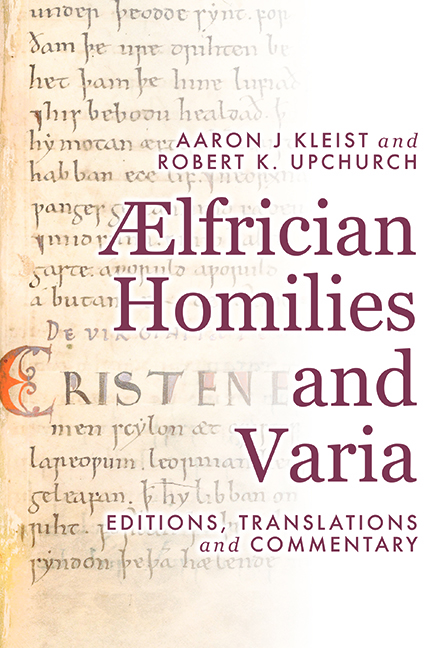Book contents
- Frontmatter
- Contents
- Preface
- Acknowledgements
- Abbreviations
- Sigla for Cited Ælfrician Manuscripts
- Dates for Cited Ælfrician Works
- Editorial Conventions
- Conventions Used in the Commentaries
- Homilies The Proper of the Season
- Homilies The Proper of the Saints
- Ælfrician Homilies and Varia: Editions, Translations, and Commentary: Volume II
- Homilies The Common of the Saints
- Homilies Unspecified Occasions
- Varia
- Works Cited
- Index
- ANGLO-SAXON TEXTS
22 - Se Læssa Creda (‘The Shorter Creed’) [Apostles’ Creed]
Published online by Cambridge University Press: 05 March 2024
- Frontmatter
- Contents
- Preface
- Acknowledgements
- Abbreviations
- Sigla for Cited Ælfrician Manuscripts
- Dates for Cited Ælfrician Works
- Editorial Conventions
- Conventions Used in the Commentaries
- Homilies The Proper of the Season
- Homilies The Proper of the Saints
- Ælfrician Homilies and Varia: Editions, Translations, and Commentary: Volume II
- Homilies The Common of the Saints
- Homilies Unspecified Occasions
- Varia
- Works Cited
- Index
- ANGLO-SAXON TEXTS
Summary
It had long been commonplace by Ælfric's day that a creed and the Paternoster were the two texts most necessary for all Christians to know. A creed taught them what to believe, while the Lord's Prayer taught them how to pray. And since a knowledge of both comprised a ‘minimum standard of orthodox belief’, Ælfric expected priests to teach and to explain them to the laity. To those ends, he issued sermons on the Lord's Prayer (CH I.19) and the Creed (CH I.20) in his First Series of Catholic Homilies (989) and then in 992 provided stand-alone translations of the Paternoster and two Creeds. Se Læssa Creda (‘The Shorter Creed’) is his translation of the Apostles’ Creed that godparents and adult converts would recite during the baptismal liturgy and that the clergy would say as part of the daily round of worship services known as the Divine Office. The creed edited in the next chapter is his translation of the formulation traditionally called the Nicene Creed, now referred to by scholars as the Niceno-Constantinopolitan Creed. Ælfric designates it the Mæsse Creda (‘Mass Creed’) because it was recited during the Canon of the Mass, the set of prayers used to consecrate the Eucharist. He also knew but did not translate the so-called Athanasian Creed or Quicumque uult (after its opening words, ‘Whoever wishes’), which he would have recited at Easter as part of the Divine Office. This is the longest of the three creeds known to Ælfric and focuses more on the unity among the three persons of the Trinity than the other two. He mixes elements from the Athanasian and Nicene confessions of faith in his exposition of the Creed (CH I.20), but he never, indicates or states a preference for the Nicene Creed (Mass Creed) over the Apostles’ Creed (The Shorter Creed). He cares only that priests teach the laity a creed to recite (or to sing to ward off evil on a journey) and that they explain to them the tenets of the faith Christians use the creed to confess.
Ælfric was not the only Anglo-Saxon author to translate the Apostles’ Creed, but he is the only one we know of to have translated it as a stand-alone catechetical text.
- Type
- Chapter
- Information
- Ælfrician Homilies and VariaEditions, Translations, and Commentary, pp. 929 - 944Publisher: Boydell & BrewerPrint publication year: 2022

